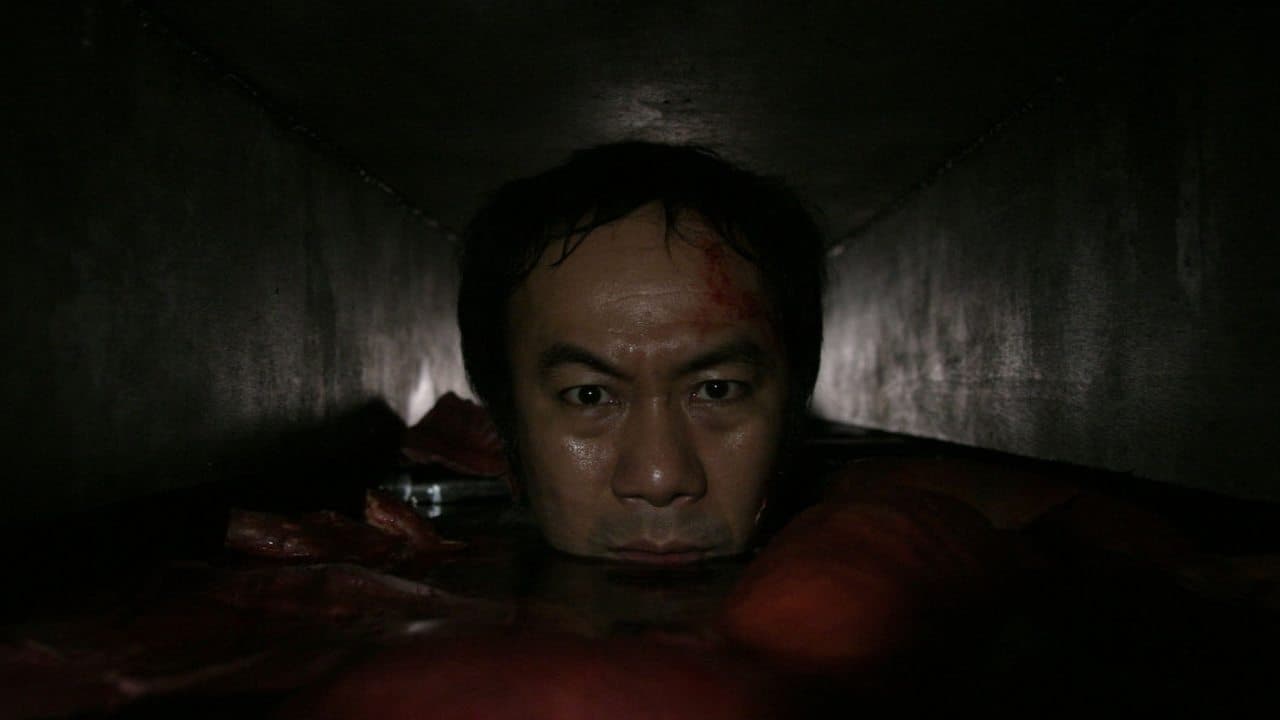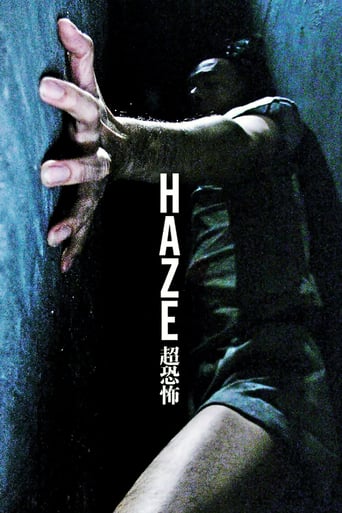

A man wakes up in an endless black maze, with only a few inches of head room, forced to crawl around fruitlessly, all with no idea where he is or how he got there. The only respite from this is the torment he receives from various booby traps and his brief glimpses into chambers in which torture, dismemberment, and various unspeakable acts are committed upon other hapless victims by unseen agents. Yes folks, the word "grim" doesn't really even begin to describe this one.Tsukamoto brings us a punishing, claustrophobic nightmare on film that defies explanation, including the obvious one that the characters are dead and in hell. While the "person wakes up in room with no idea who he is or how he got there" device is well worn, it remains so effective simply because it can be a metaphor for almost anything. Rarely is it used as well as it is here, despite the absence of easy interpretations.I've never been great at speculating about the "true" meaning of a film like this, but I will say that it seems to involve the aftermath of an altercation of some kind in which the man and a woman in his life both receive stab wounds to the abdomen. We don't learn much more than that, but the last 5 to 10 minutes completely open the possibilities, and surprisingly, provide something resembling an upbeat conclusion. Well, sort of. Intriguingly, "Abandon all hope, ye who enter here" is not quite the sign posted here.Speaking of the afterlife, if that's what this is, this particular vision of damnation is astonishingly similar to the one that has haunted me as long as I can remember. Being forced to crawl around in a dark, extremely tight space for all eternity is apparently the very personal conception of hell that I in fact share with many others, or at least with Tsukamoto. If you're one of us, then consider this a warning or, if you like, an invitation to watch. Suffice it to say, this is not for all tastes or moods. But if you want something that makes Cube seem like a cheerful, feel-good film, this might just be the one for you.
... View MoreA man wakes up in a dark claustrophobic space, he is wounded in the abdomen and does not know how he got there. This is not just a description of a prison, and wounds received from a sadist, this is an allegorical perspective on existence itself. Some have chosen to interpret this in a materialist perspective, I think that's valid, but I think there is also a distinctly Platonic way of looking at the movie, I elaborate on both below.From the materialist perspective, we arrive into consciousness, ex nihilo, from nothing, and return to nothing. Born into pain, degrading into dust. In this view, life is a cold miracle, sentience an evolutionary adaptation: psychology a consequence of biology, biology a consequence of chemistry, chemistry a consequence of physics; a gob-smacking and dastardly chain of entirely coincidental and parasitic ectropy.The stomach wound which the man and the woman he happens across have, may well also be allegorical. There is a tradition of love, recounted by Aristophanes in Plato's Symposium, which says that men and women are shards split asunder by Zeusian thunderbolts from original genderless beings. The trauma of this violent splitting is the natural state of existence. Humans are only whole again once rejoining. The male prisoner in the movie refers to his only remaining memory, of having watched fireworks alone on a cold landscape, and that there was no apparent organiser. This is the material world, where there is beauty there for us to perceive, a cold beauty, created by nobody. The only true way to appreciate the beauty of the display is with a companion, and we are shown the male and female later observing such a display. Who amongst us has not thought, on perceiving a wonder alone, "Oh, I wish someone was here to witness this with me." The man and woman in this movie unite to give each other the strength to escape the prison, this is the synergy of love.Another more religious view is also to be found in The Symposium, the view of Diotima, which is that realising the true beauty of another person (as opposed to their physical beauty), through love, is a step on the path to the contemplation of the beauty of all things, and the beauty of the divine. Buddhism has a similar concept where true unselfish love (as opposed to the merely erotic) is a step on the path to enlightenment. You can see the scene of the prisoner as an old man luxuriating in the luminous white sheets on the building top at the end of the movie as a representation of this enlightenment, or peace. The beginning of the movie under this interpretation, is ignorance of beauty, the natural origin state of disquietude and upset, or the Buddhist term dukkha.The whole movie was like a stamen loaded with philosophical pollen. The way it is filmed, so that we never really see the whole cell in the round, how we see things fleetingly and fractured is pretty epistemological. The male prisoner sees occasional glimpses into unreachable other cells where acts of dimly perceivable tremendous horror are played out. This speaks of the difficulty of contact, of true contact, where humans see each other, really see, look into another's eyes, seeing what they are about, their true beautiful core. For me, like Last Year in Marienbad, the film is about the will to love, about the nature of love, and the purpose of love.
... View MoreThe thing about Haze... First I have to say that the DVD costs about 20, that's a bit expensive if you expect a full movie and in the end only get a short-film, BUT, the director once again creates a dark industrial set with a bit of organic flair. Just the way I like it! It's not as horrific as Tetsuo or Brutal as Tokyo Fist, it has more from his last movie Vital mixed with the craziness of his early films. In an interview he says himself that in his eyes the movie is between Tesuo and Tokyo Fist and I think thats not the worse description. All in all it's worth a look, but before you buy it for a high price better check out your next DVD-Rental-Store and have a look for yourself. About the German DVD release from rem (RapidEyeMovie) I can say that it has a beautiful but for the Label standard made Box with a Poster. The Extras on the DVD are okay, I think about 6 Trailers and an Making Of and an interview with the director ('bout 15 min). So Dude's check it out and have fun!
... View MoreThis movie, although only 40 minutes long, sends Saw and Cube back to kindergarten, making it look stupid, shallow and pointless. Once again Shinya Tsukamoto proves that he is one of the most challenging, thought-provoking and original directors of today, absolutely not afraid of pushing boundaries in terms of what might be shown on celluloid. And he knows pretty well what scares us, oh yes. It's like your worst, fever-induced nightmares come surprisingly alive, and I'm not talking about waking up in a completely darkened, concrete maze. It might be a parallel for war, genocide or just totally painful, desperate loneliness... or just a statement that, after all, we are nothing more than a piece of meat which happened to have a tiny spark of life inside... This movie raises so many questions... and even if most of them remain unanswered, it is worth to feel really uncomfortable for this 40 minutes. Some people will probably start having nightmares like this, but for me it was more like a relief that Tsukamoto and his protagonist lived it for me...
... View More